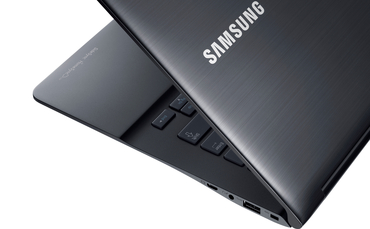Just last month, we looked at the Gigabyte U2442F, a £1,000 "ultrabook" with a stonking Intel Core i7 microprocessor, an excellent, dedicated 2GB NVIDIA graphics card - and a truly terrible screen.

We noted not only that it seemed unbalanced - marrying a fab graphics card capable of playing Crysis 2 at maximum resolution with a non-touch screen that looked like it had been pinched from a cheap Acer laptop - but that it seemed a steep price to pay for a laptop with a rather modest, 128GB solid-state disc (SSD).
And lo-and-behold, what should turn up next than something (at least superficially) similar for half the price - about £500 for the non-touch-screen version and £600 for touch. But how does it measure up in real-world usage, and does it offer value for money compared to other devices at around the same price?
Starting on the outside, Samsung has eschewed the temptation to try and make its device look like a Macbook and instead designed a laptop that looks pretty good, but different. It is thinner, but not lighter, and has some elegant curves holding the screen hinge in place. The "mineral black ash" (ie: black) version looks particularly smart, in our opinion. It is also available in white.
There are two versions of the ATIV Book 9 Lite - touch and non-touch.
We reviewed the touch screen version as Windows 8 seems a bit pointless (and even more annoying) without a touch screen. It offers a standard resolution of 1366 by 768 over 13.3 inches, but is bright and colourful with reasonable (but not spectacular) viewing angles considering its price - it's certainly better than the Gigabyte U2442F in that respect. The speaker, too, is decent enough for the price and more than adequate for watching BBC iPlayer.
Inside, it sports a quad-core AMD A6-1450 budget microprocessor, together with an integrated AMD HD 8250 graphics processing unit (GPU). It comes with 4GB of memory, although the Control Panel suggests you have just 3.44GB to play with, and up to 2GB of this will be shared with the GPU. And, no, in true Apple iPad-style none of this is expandable or replaceable unless you're willing to get out the Phillips screwdrivers, crack open the case, invalidate your warranty and hope for the best.
The keyboard is another chiclet-style affair, but much quieter than the Gigabyte's, while the mouse pad is good for zipping around the screen (when not using touch), but the buttons on the pad can be both unresponsive and finickity. For example, right-clicking to bring up a menu frequently registered as a left click/select. The buttons are also built under the track pad, which could also be awkward when manipulating the pointer while the finger is hovering on the button.
Furthermore, it has no features for fast scrolling, which is disappointing, nor any option to turn the touch pad off. While it commendably doesn't interfere too often with touch-typing, which is an indication of good ergonomics, it can sometimes relocate the cursor mid-type with predictably irritating results.
In action
Downloading the initial software we needed to test the machine - Opera, Adobe Flash, Steam, benchmarks etc - we found it disconcertingly unresponsive and, frankly, slow for a laptop with an SSD. It could take up to 10 seconds for simple dialog boxes to appear when, for example, we were installing Flash.





